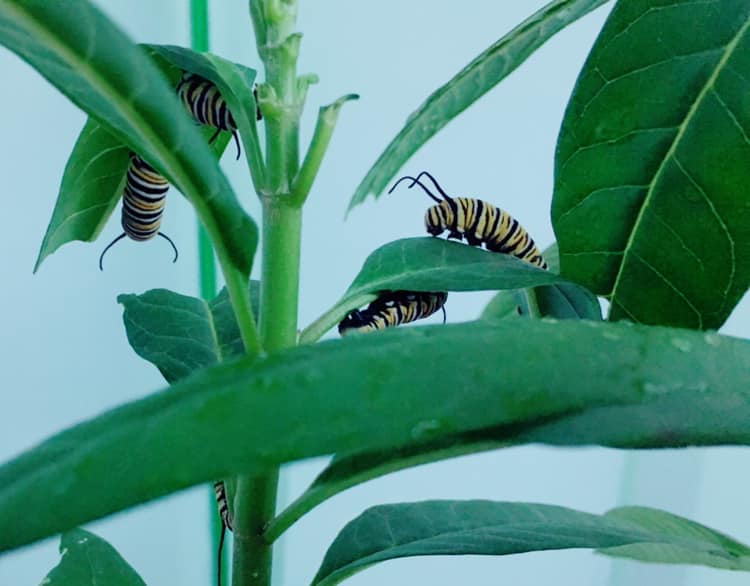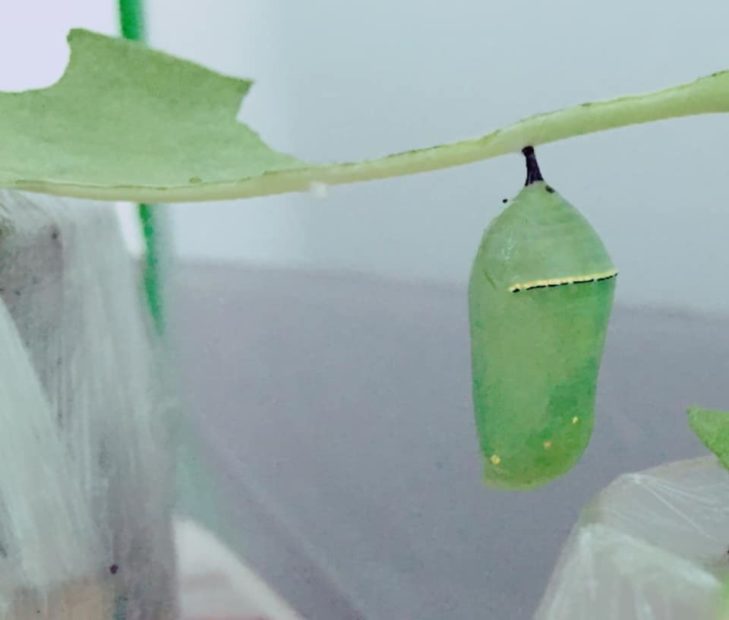
Saving the Monarchs is easy and inexpensive; it just takes patience and planting milkweed (the only thing the caterpillars eat!!). If we all get involved we can make a big difference.
Common milkweed grows abundantly in many areas of the US starting in June. Other types of milkweed, such as tropical or swamp milkweed, easily grow as well. You can harvest milkweed, locate monarch eggs, and easily raise 100 caterpillars indoors in what is called a “butterfly hamper” until they pupate. Upon leaving the chrysalis you release them 24 hours later bearing the weather. Super easy! If you want a lower maintenance approach, even planting nectar flowers AND milkweed helps immensely.

Egg found on common milkweed 
My caterpillars eating tropical milkweed. 
Our first chrysalis of 2019!
Create a Monarch Waystation
Plant nectar flowers and milkweed for wandering monarchs to have a place to rest and eat. Some great, low-maintenance plants for butterflies are: cone flowers, Black-eyed Susans, hollyhocks, meadow blazing stars, and, of course, milkweed flowers! Learn more here.
Hungry, Hungry Hippos
Monarch caterpillars, or any caterpillars really, eat A LOT. That means you’ll need a lot of milkweed. Milkweed is the only thing monarch caterpillars can eat. Each caterpillar can easily devour a whole plant before preparing to make its chrysalis. If you can’t grow or locate enough milkweed to feed your caterpillars, only bring in as much as you can feed. In Indianapolis it literally grows wild in ditches, forests, and medians.
You’ll have to place fresh milkweed in your “butterfly hamper” which is what we call a zippable mesh insect cage, daily. You will also have to remove caterpillar poo/frass everyday as well. (They eat and poop non-stop.) Other than that I prefer to place my chrysalis in a separate hamper so no diseases are transmitted to young caterpillars. When the butterfly emerges and dries their wings for 24 hours, release it on a nice, sunny day. If you need to wait a little longer because it’s raining or dark soon, please offer a nectar flower or orange slice just in case! This website was the site I used for information raise mine, they seem to have the process covered very nicely from what cage to how to keep milkweed fresh!

Prefer to Leave Them Outside?
Why bring them in at all? Haven’t they survived until now?
The percentage of monarchs that survive from egg to adulthood is very low. Researchers agree that less than 10% of the eggs that are laid survive to become adult butterflies, and some feel that this number may be significantly under 10%. – Monarch Joint Venture
Overall monarchs have declined by more than 80 percent over the past two decades.
Scientists estimate the monarch population needs to reach 225 million butterflies to be out of the danger zone. Monarchs have lost an estimated 165 million acres of breeding habitat in the United States to herbicide spraying and development. – Center for Bio Diversity
How to Raise Monarch Butterflies FaceBook Group
Join us and get involved!